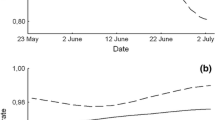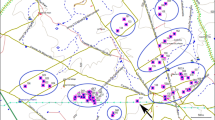Abstract
During 2002–2005 we analyzed Lack’s Hypothesis about the timing of the breeding of marsh harriers (Circus aeruginosus) in the Poodří to the breeding period and preference of heterogeneous habitat. An analysis of 43 nests revealed quantitative differences. Birds which started breeding earlier, reached significantly higher reproductive success than later breeding birds regardless of nesting habitat (P = 0.003, n nests = 43). Even when the birds invested into their offspring the same way, their breeding success was not always the same. When the females nested in the common reed (Phragmites communis), they reached higher reproductive output than females nesting in cattail (Typha sp.) (P = 0.01, n cattail = 18, n common reed = 25). The habitat of the common reed is characterized by higher and denser vegetation cover than cattail vegetation (P < 0.001, n measurements = 174 for both variables).
Similar content being viewed by others
References
Altenburg W., Bruinenberg-Rinsma J., Wildschut P. & Zijlstra M. 1987. Colonization of a new area by the Marsh Harrier. Ardea 75: 213–220.
Arnold K. 2004. Seasonal declines in reproductive success of the common tern Sterna hirundo: Timing or parental quality? J. Avian Biol. 35: 33–45.
Arroyo B., Mougeot F. & Bretagnolle V. 2001. Colonial breeding and nest defence in Montagu’s harrier (Circus pygargus). Behav. Ecol. Sociobiol. 20: 109–115.
Báldi A. & Kisbenedek T. 1998. Factors influencing the occurrence of Great White Egret (Egretta alba), Mallard (Anas platyrhynchos), Marsh Harrier (Circus aeruginosus), and Coot (Fulica atra) in the reed archipelago of Lake Velence, Hungary. Ekologia (Bratisl.) 17: 384–390.
Batáry P., Winkler H. & Báldi A. 2004. Experiments with artificial nests on predation in reed habitats. J. Ornithol. 145: 59–63.
Bavoux C., Burneleau G. & Pikard M. 1998. Marsh Harriers Cirus a. aeruginosus breeding in Charente-Maritime (West France), data analysis regarding the age of breeding birds. Alauda 66: 299–305.
Bock W.F. 1978. Jagdgiebet und Ernährung der Rohrweihe (Circus aeruginosus) in Schlezwig-Holstein. J. Ornithol. 119: 298–307.
Brinkhof M.W.G, Cavé A.J., Daan S. & Perdeck A.C. 2002. Timing of current reproduction directly affects future reproduction output in European Coots. Evolution 56: 400–411.
Childress R.B. & Bennun L.A. 2002. Sexual character intensity and its relationship to breeding timing, fecundity and mate choice in the great cormorant Phalacrocorax carbo lucidus. J. Avian Biol. 33: 23–30.
Chytry M., Kučera T. & Kočí M (eds) 2001. Habitat catalogue of the Czech Republic. AOPK ČR Praha, 304 pp.
Cramp S. & Simmons K.E.L. 1980. The Birds ofWestern Palearctic. Vol. 2. Oxford Univ. Press, Oxford, 695 pp.
Culek M. (ed.) 1996. Biogeografické členění České republiky. Enigma, Praha, 347 pp.
Daan S., Dijkstra C. & Tinberger J.M. 1990. Family planning in the Kestrel (Falco tinnunculus): The ultimate control of covariation of laying date and clutch size. Behaviour 114: 83–116.
Del Hoyo J., Elliott A. & Sargatal J. (eds) 1994. Handbook of the Birds of the World. Vol. 2. New Vultures to Guineafowl. Lynx Edition, Barcelona, 638 pp.
Dijkstra C. & Zijlstra M. 1997. Reproduction of Marsh harriers Circus aeruginosus in recent land reclamations in the Netherlands. Ardea 85: 37–50.
Fernández C. 1992. Nest material supplies in the Marsh Harriers Circus aeruginosus: sexual roles, daily and seasonal activity patterns and rainfall influence. Ardea 80: 281–284.
Fiala V. 2001. Moták pochop (Circus aeruginosus) na Náměštských rybnících 1955–2000. Crex 17: 44–58.
Forsman D. 1999. The Raptors of Europe and the Middle East. A Handbook of Field Identification. Poyser, London, 589 pp.
Franklin A.B., Anderson D.R., Gutiérez R.J. & Burnham K. 2000. Climate, habitat quality, and fitness in northern spotted owl populations in northern California. Ecol. Monogr. 70: 539–570.
García J.T. & Arroyo B.E. 2002. Intra-and interspecific agonistic behaviour in sympatric harriers during the breeding season. Anim. Behav. 64: 77–84.
Glutz von Blotzheim U.K., Bauer M. & Bezzel E. 1971. Handbuch der Vögel Mitteleuropas. 4. Akademische Verlagsgesellschaft, Frankfurt am Main, 943 pp.
Hudec K. & Šťastný K. (eds) 2005. Ptáci — Aves. Díl II/1 (2. přepracovaněné vydání). Academia, Praha, 572 pp.
Hussell D.J.T. 2003. Climate change, spring temperatures, and timing of breeding of Tree Swallows (Tachycineta bicolor) in Southern Ontario. The Auk 120: 607–618.
Koks B. 1994. Marsh Harrier Circus aeruginosus builts tree-nest. De Takkeling 2: 15–18.
Kostrzewa R. & Kostrzewa A. 1991. Winter weather, spring and summer density, and subsequent breeding success of Eurasian kestrels, Common buzzard, and Northern goshawks. The Auk 108: 342–347.
Krüger O. 2002. Dissecting common buzzard lifespan and lifetime reproductive success: the relative importance of food, competitions, weather, habitat and individual attributes. Oecologia 133: 474–482.
Krüger O. 2004. The importance of competition, food, habitat, weather and phenotype for the reproduction of Buzzard Buteo buteo. Bird Study 51: 125–132.
Kunstmüller I. & Hlaváč V. 1988. Unusually nesting of the Marsh Harrier (Circus aeruginosus) on the pine-tree top. Buteo 3: 43–46.
Lack D. 1968. Ecological Adaptations for Breeding in Birds. Methuen and Co., London, 409 pp.
Ludwigs J.D. & Becker P.H. 2002. The hurdle of recruitment: influences of arrival date, colony experience and sex in the Common Tern Sterna hirundo, pp. 389–399. In: Both C & Piersma T. (eds), The avian calendar: exploring biological hurdles in the annual cycle. Proc. 3rd Conf. European Ornithol. Union, Groningen, August 2001. Ardea 90(3) Special Issue.
Martin T.E. 1998. Are mirohabitat preferences of coexisting species under selection and adaptive? Ecology 79: 656–670.
Martin T.E. & Roper J.J. 1988. Nest predation and nest site selection in a western population of the Hermit Thrush. Condor 90: 51–57.
Mc Donald P.G., Olsen P. & Cockburn A. 2004. Weather dictates reproductive success and survival in the Australian brown falcon Falco berigora. J. Anim. Ecol. 73: 683–692.
Millon A., Bourrioux J.L., Riols C. & Bretagnolle V. 2002. Comparative breeding biology of Hen Harrier and Montagu’s Harrier: an 8-year study in north-eastern France. Ibis 144: 94–105.
Moore M.C. 1980. Habitat structure in relation to population density and timing of breeding in prairie warblers. Wilson Bull. 92: 177–187.
Newton I. 1979. Population Ecology of Raptor. Poyser, London, 399 pp.
Němečková I. 2005. The influence of nesting habitat on the reproductive success of Marsh Harriers Circus aeruginosus in the Protected landscape area Poodří: timing of breeding. Alauda 73: 312–313.
Perrins C.M. 1965. Population fluctuations and clutch size in the Great Tit Parus major. J. Anim. Ecol. 34: 601–647.
R Development Core Team 2005. R: A Language and Environment for Statistical Computing. R foundation for Statistical Computing, Vienna, Austria, www.R-project.org (accessed 15.08.2007).
Redpath S., Madders M., Donnelly E., Anderson B., Thirgood S., Martin A. & Mc Leod D. 1998. Nest site selection by Hen Harriers in Scotland. Bird Study 45: 51–61.
Redpath S., Arroyo B.E., Etheridge B., Leckie F., Bouwman K. & Thirgood S.J. 2002. Temperature and hen harrier productivity: from local mechanisms to geographical patterns. Ecography 25: 533–540
Ruxová A. 1998. Another case of atypical nest site. Zprávy ČSO 47: 23–24.
Schipper W.J.A. 1979. A comparison of breeding ecology in three European Harriers — (Circus). Ardea 66: 77–102.
Simmons R. 1989. How polygynous female Northern Harriers Circus cyaneus choose their mates and why they are deceived, pp. 243–245. In: Meyburg, B.U. & Chancellor, R.D. (eds), Raptors in the Modern World, WWGBP, Berlin, London & Paris.
Steenhof K. & Kochert M.N. 1999. Long-term prairie falcon population changes in relation to prey abundance, weather, land uses, and habitat conditions. The Condor 101: 28–41.
Stenseth N.C. & Mysterud A. 2002. Climate, changing phenology, and other life history traits: Nonlinearity and matchmismatch to the environment. Proc. Natl. Acad. Sci. U.S.A. 99: 13379–13381.
Underhill-Day J.C. 1984. Population and breeding biology of Marsh Harriers in Britain since 1900. J. Appl. Ecol. 21: 773–787.
Verboven N., Tinbergen J.M. & Verhulst S. 2001. Food, reproductive success and multiple breeding in the Great Tit Parus major. Ardea 89: 387–406.
Weidinger K. 2003. Hnízdní úspěšnost — co to je a jak se počítá [Nest success — definition, estimate and analysis]. Sylvia 39: 1–24.
Wiggins D.A., Pärt T. & Gustafsson L. 1998. Timing of breeding and reproductive cost in collared flycatchers. The Auk 115: 1063–1067.
Witkowski J. 1989. Breeding biology and ecology of the Marsh Harrier (Circus aeruginosus) in the Barycz Valley, Poland. Acta Ornitol. 25: 223–320.
Author information
Authors and Affiliations
Corresponding author
Rights and permissions
About this article
Cite this article
Němečková, I., Mrlík, V. & Drozd, P. Timing of breeding, habitat preference and reproductive success of marsh harriers (Circus aeruginosus). Biologia 63, 261–265 (2008). https://doi.org/10.2478/s11756-008-0030-2
Received:
Accepted:
Published:
Issue Date:
DOI: https://doi.org/10.2478/s11756-008-0030-2




